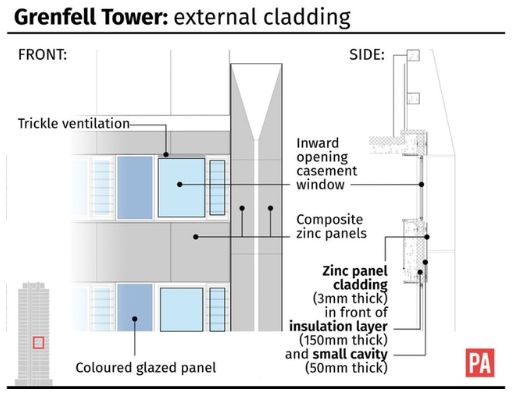Dangerous Grenfell Tower-style cladding has been removed from just 15% of high-rise buildings identified by the government in the aftermath of the disaster, official figures show.
Only 67 of 437 buildings in England above 18 metres have been stripped of aluminium composite material (ACM) cladding, data from the Ministry of Housing, Communities and Local Government reveals.
ACM is similar to the material blamed for the rapid spread of the 2017 Grenfell Tower fire, which ripped through the building and claimed 72 lives.
It means 370 high-rises across the country are “unlikely” to meet current building regulations, the government’s most recent update on progress said.
Of those, 238 are private buildings, including residential and student accommodation, and hotels.
The figures come as it emerged the ministry is facing resistance from owners to get rid of the dangerous cladding.
At Prime Ministers Questions on Wednesday, Theresa May said 56 building owners were “refusing” to remove dangerous cladding from private buildings.
“We’re maintaining pressure on this but we rule nothing out,” the Prime Minister told MPs after being warned of “hundreds of blocks draped in exactly the same highly flammable cladding” as Grenfell.

In November, councils were given government backing to strip ACM cladding from private residential buildings.
A ban on using combustible cladding on new high-rise homes – as well as schools, care homes and student accommodation – came into force on December 21.
Fears over the slow pace in removing the cladding, more than 18 months after the disaster in west London, was raised during a Commons debate this week.
Steve Reed, Labour MP for Croydon North and a shadow minster, who called the debate, said: “There are still thousands of terrified residents living in blocks with the same kind of cladding, or a very similar kind of cladding, as that which went up in flames at Grenfell Tower.
“There are still 56 private blocks of flats around the country – that is 56 – that have no clear plan in place to remove and replace it. People are left living in fear.”
He fears the ‘ban’ on cladding is not total as it does not include hotels.
In response, housing minster Kit Malthouse down-played fears over safety the 56 high-rises by saying that “100% of those buildings have temporary measures in place” certified by the local fire service as appropriate.
“He says that thousands of people are living in terror in blocks, but that should not be the case, on the basis that every local fire and rescue service has visited, inspected and agreed temporary measures with every residential building over 18 metres in height that has this cladding, and they are going back to check and monitor to make sure that they are in place,” he said.
Malthouse added that 56 private buildings yet to start remediation had fallen from more than 200 buildings last June.